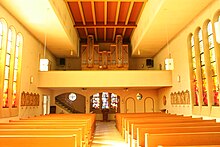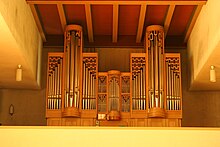Heart of Jesus (Turbenthal)
The Roman Catholic Church in Turbenthal in the Zurich district of Winterthur is called the Church of the Heart of Jesus . It is the church of the parish of St. Ulrich , which includes the communities Turbenthal, Wila , Wildberg ZH and the villages of Rämismühle and Zell. The parish belonging to it is only responsible for the places Turbenthal, Wila and Wildberg. The Catholic residents of Rämismühle and Zell ZH are entitled to vote at the parish assembly in Kollbrunn.
history
History and naming
The parish of St. Gallus in Turbenthal was first mentioned in a document in 858, when a nobleman named Reginbert the Younger transferred the church to the St. Gallen monastery . In the years 1510–1512 today's Reformed Church was built, which was used for Reformed church services from 1524 after the Reformation in Zurich . From then on, Catholic worship was forbidden. It was not until the Edict of Tolerance of 1807 that a Catholic church service was permitted again for the first time in the canton of Zurich, but only in the city of Zurich. In 1813, 50 Catholics living in the city of Winterthur appealed to the city fathers to be tolerant . However, it was not until 1862, when the Rheinau monastery was abolished and the further use of its property was legally regulated by the canton of Zurich, that the first Catholic service since the Reformation was allowed to take place in Winterthur. The so-called First Zurich Church Law from 1863 recognized Zurich as well as the Catholic parishes in Winterthur, Rheinau and Dietikon (the last two were traditionally Catholic places), so that a Catholic parish could be established in Winterthur. In 1868 the newly built St. Peter and Paul Church was opened in the presence of representatives of the cantonal government, including state clerk and poet Gottfried Keller, and the city council of Winterthur. However, the establishment of further parishes in the canton was not recognized by the state, which is why these had to be set up on the basis of private and association law, including the parish Herz Jesu Turbenthal.
Development and construction history
The church of St. Antonius was built in Kollbrunn in the lower Tösstal in 1897 , to which the Catholics in the area of today's parish Herz Jesu Turbenthal came on foot or by train for worship. When the trains on Sunday were stopped in 1918 during World War I , the pastor of Kollbrunn was able to rent a room in the primary school in Hutzikon. At the Epiphany in 1919, the first service was held in the classroom that had been converted into a chapel. In 1931 the Bishop of Chur , Georg Schmid von Grüneck , commissioned Pastor Hugo Paul to build a parish in Turbenthal. This was built up from parts of the neighboring parishes of Kollbrunn, Bauma and Pfäffikon ZH . On February 12, 1934, the excavation work for the construction of the church and the rectory began. The house of God was built by the Stuttgart architect Albert Otto Linder . On the 2nd Sunday after Easter, on April 15, 1934, the Bishop of Chur, Laurenz Matthias Vincenz , consecrated the foundation stone of the church in honor of the Sacred Heart of Jesus . On November 25, 1934, the church and the rectory were consecrated by the Chur bishop.
The parish of St. Ulrich has 1,367 members (as of 2017) and is one of the small Catholic parishes in the canton of Zurich.
Building description
Church tower and exterior
The architect of the building was church builder Albert Otto Linder from Stuttgart. The church has a length of 25 m, a width of 12.50 m. The height of the church is 13 m from the ground to the roof ridge, the height of the central nave is 7.50 m to the wooden beam ceiling. Located on Schulstrasse , the building ensemble consists of the church and the rectory attached at right angles. A wide staircase leads to the church portal, above which a Christ designed by Emil Sutor blesses those entering. To the left and right of this Christ statue, a woman and a man with children look hopefully at Christ. The church tower contains a four-part bell, which was cast by the Fritz Hamm foundry in Staad and consecrated in Turbenthal on October 27, 1934.
| number | Weight | volume | dedication |
|---|---|---|---|
| 1 | 1600 kg | d | Christ the King |
| 2 | 750 kg | f sharp | Maria |
| 3 | 450 kg | a | Ortisei |
| 4th | 320 kg | H | Guardian Angel |
Interior and artistic equipment
The three-aisled church is designed as a path church , in that the entire interior design, including the benches of the believers, is aligned with the Christ statue in the choir. When entering the church, the believer can also inwardly understand his own path as a Christian. The baptistery is located at the church entrance and reminds believers of their own baptism. Above the baptismal font , the stained glass window depicts the baptism of Jesus by John the Baptist . Left and right in the stained glass window the words: “I baptize you in the name of the Father and the Son and the Holy Spirit. Amen. ”After being accepted into the ecclesial community through baptism, the path of the believer leads to the main room of the church, which faces the sanctuary, where the sacrament of the Eucharist is celebrated and where a statue of the risen Christ is placed on the choir wall is. On the left of him St. Theresa of the Child Jesus prays to Christ, on the right Bishop Ulrich von Augsburg can be seen. To the left of the chancel, which is separated from the nave by steps, is the tabernacle on the front wall of the aisle , above which the Holy Spirit hovers in the form of a dove. On the right side of the chancel, a statue of Our Lady is attached to the front wall of the second aisle. Daylight falls through a window front, which is located on both sides of the nave of the church. The glass windows bathe the church in red and gold light. The main furnishings of the church came from the sculptural work of Emil Sutor.
organ
On October 29, 1934 the first organ was installed in the Church of the Sacred Heart of Jesus. It was an instrument with ten registers built by the Mayer brothers from Buchs- Feldkirch and designed by the organist L. Favini. In 1979 the company Späth Orgelbau , Rapperswil, built today's instrument. The 13 registers are distributed over two manuals including pedal. The action and registration are purely mechanical. The organ has slider chests and a free wind supply. Werckmeister III was used as the temperature control . Rudolf Meyer carried out the project planning and advice, the intonation was carried out by Martin Pflüger. In 2012 the instrument was revised by Orgelbau Späth.
|
|
|
||||||||||||||||||||||||||||||||
- Coupling : II / I (interactive) I / P, II / P
literature
- Episcopal Ordinariate Chur (ed.): Schematism of the Diocese of Chur. Chur 1980.
Web links
Individual evidence
- ↑ Bischöfliches Ordinariat Chur (Hrsg.): Schematismus. P. 259.
- ^ Peter Niederhäuser and Flurina Pescatore: St. Peter and Paul. The mother church of Katholisch-Winterthur. Pp. 7-17.
- ↑ site of the parish www.herzjesu-turbenthal.ch section history. ( Memento from May 2, 2014 in the Internet Archive )
- ↑ Markus Weber, Stephan Kölliker: Sacred Zurich. 150 years of Catholic church building in the canton of Zurich , S, 227.
- ↑ Catholic Church of the Canton of Zurich (Ed.): Annual Report 2017 , p. 84.
- ^ Parish website, About Us section . ( Memento from May 2, 2014 in the Internet Archive )
Coordinates: 47 ° 26 '20.1 " N , 8 ° 50' 48.2" E ; CH1903: 706,214 / 255189



